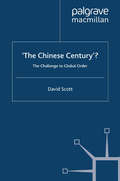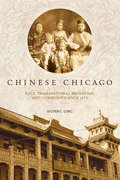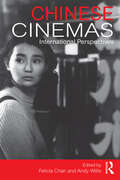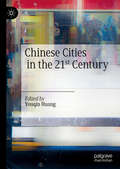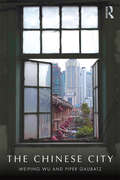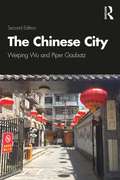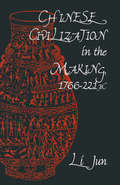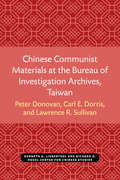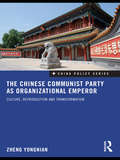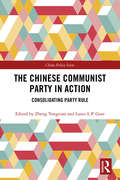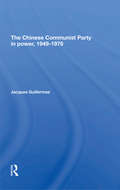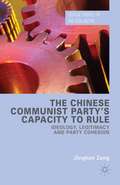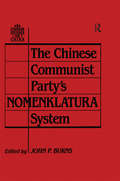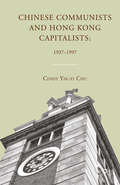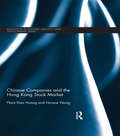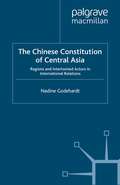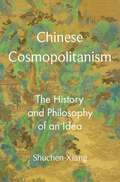- Table View
- List View
'The Chinese Century'?: The Challenge to Global Order (Global Issues)
by D. ScottThis book looks ahead to consider the most likely results of the encounter between China and the international system. Environmental, cultural and perceptual matters are considered as well as more traditional economic and military issues. Underpinning the book is the question will the 21st century be 'China's Century', for China and the world?
Chinese Chicago: Race, Transnational Migration, and Community Since 1870 (Asian America #74)
by Huping LingNumerous studies have documented the transnational experiences and local activities of Chinese immigrants in California and New York in the late nineteenth and early twentieth centuries. Less is known about the vibrant Chinese American community that developed at the same time in Chicago. In this sweeping account, Huping Ling offers the first comprehensive history of Chinese in Chicago, beginning with the arrival of the pioneering Moy brothers in the 1870s and continuing to the present. Ling focuses on how race, transnational migration, and community have defined Chinese in Chicago. Drawing upon archival documents in English and Chinese, she charts how Chinese made a place for themselves among the multiethnic neighborhoods of Chicago, cultivating friendships with local authorities and consciously avoiding racial conflicts. Ling takes readers through the decades, exploring evolving family structures and relationships, the development of community organizations, and the operation of transnational businesses. She pays particular attention to the influential role of Chinese in Chicago's academic and intellectual communities and to the complex and conflicting relationships among today's more dispersed Chinese Americans in Chicago.
Chinese Cinemas: International Perspectives
by Felicia Chan Andy WillisChinese Cinemas: International Perspectives examines the impact the rapid expansion of Chinese filmmaking in mainland China has had on independent and popular Chinese cinemas both in and outside of China. While the large Chinese markets are coveted by Hollywood, the commercial film industry within the People’s Republic of China has undergone rapid expansion since the 1990s. Its own production, distribution and exhibition capacities have increased exponentially in the past 20 years, producing box-office success both domestically and abroad. This volume gathers the work of a range of established scholars and newer voices on Chinese cinemas to address questions that interrogate both Chinese films and the place and space of Chinese cinemas within the contemporary global film industries, including the impact on independent filmmaking both within and outside of China; the place of Chinese cinemas produced outside of China; and the significance of new internal and external distribution and exhibition patterns on recent conceptions of Chinese cinemas. This is an ideal book for students and researchers interested in Chinese and Asian Cinema, as well as for students studying topics such as World Cinema and Asian Studies.
Chinese Cinemas: International Perspectives
by Felicia Chan Andy WillisChinese Cinemas: International Perspectives examines the impact the rapid expansion of Chinese filmmaking in mainland China has had on independent and popular Chinese cinemas both in and outside of China. While the large Chinese markets are coveted by Hollywood, the commercial film industry within the People’s Republic of China has undergone rapid expansion since the 1990s. Its own production, distribution and exhibition capacities have increased exponentially in the past 20 years, producing box-office success both domestically and abroad. This volume gathers the work of a range of established scholars and newer voices on Chinese cinemas to address questions that interrogate both Chinese films and the place and space of Chinese cinemas within the contemporary global film industries, including the impact on independent filmmaking both within and outside of China; the place of Chinese cinemas produced outside of China; and the significance of new internal and external distribution and exhibition patterns on recent conceptions of Chinese cinemas. This is an ideal book for students and researchers interested in Chinese and Asian Cinema, as well as for students studying topics such as World Cinema and Asian Studies.
Chinese Cities in the 21st Century
by Youqin HuangThis book is an interdisciplinary examination of China's new urban development model and the challenges Chinese cities face in the 21st century. China is in the midst of a historic developmental inflection point, grappling with a significantly slowing economy, rapidly rising inequality, massive migration, skyrocketing housing prices, alarming environmental problems, and strong pushback from the West. In this volume, Western and Chinese scholars in different disciplines offer the clearest look yet at some of the main challenges China faces, including domestic and international contexts, the new urban development model, inclusion and well-being of migrants and their families, and urban sustainability. This book sheds light on China’s ongoing development and future directions, and has strong policy implications for anyone interested in the future of China.
The Chinese City
by Weiping Wu Piper GaubatzChina’s cities are home to 10 percent of the world’s population today. They display unprecedented dynamism under the country’s surging economic power. Their remarkable transformation builds on immense traditions, having lived through feudal dynasties, semicolonialism, and socialist commands. Studying them offers a lens into both the complex character of the changing city and the Chinese economy, society, and environment. This text is anchored in the spatial sciences to offer a comprehensive survey of the evolving urban landscape in China. It is divided into four parts, with 13 chapters that can be read together or as stand-alone material. Part I sets the context, describing the geographical setting, China’s historical urban system, and traditional urban forms. Part II covers the urban system since 1949, the rural–urban divide and migration, and interactions with the global economy. Part III outlines the specific sectors of urban development, including economic restructuring, social–spatial transformation, urban infrastructure, and urban land and housing. Finally, part IV showcases urbanism through the lens of the urban environment, lifestyle and social change, and urban governance. The Chinese City offers a critical understanding of China’s urbanization,exploring how the complexity of the Chinese city both conforms to and defies conventional urban theories and experience of cities elsewhere around the world. This comprehensive book contains a wealth of up-to-date statistical information, case studies, and suggested further reading to demonstrate the diversity of urban life in China.
The Chinese City
by Weiping Wu Piper GaubatzChina’s cities are home to 10 percent of the world’s population today. They display unprecedented dynamism under the country’s surging economic power. Their remarkable transformation builds on immense traditions, having lived through feudal dynasties, semicolonialism, and socialist commands. Studying them offers a lens into both the complex character of the changing city and the Chinese economy, society, and environment. This text is anchored in the spatial sciences to offer a comprehensive survey of the evolving urban landscape in China. It is divided into four parts, with 13 chapters that can be read together or as stand-alone material. Part I sets the context, describing the geographical setting, China’s historical urban system, and traditional urban forms. Part II covers the urban system since 1949, the rural–urban divide and migration, and interactions with the global economy. Part III outlines the specific sectors of urban development, including economic restructuring, social–spatial transformation, urban infrastructure, and urban land and housing. Finally, part IV showcases urbanism through the lens of the urban environment, lifestyle and social change, and urban governance. The Chinese City offers a critical understanding of China’s urbanization,exploring how the complexity of the Chinese city both conforms to and defies conventional urban theories and experience of cities elsewhere around the world. This comprehensive book contains a wealth of up-to-date statistical information, case studies, and suggested further reading to demonstrate the diversity of urban life in China.
The Chinese City
by Weiping Wu Piper GaubatzDrawing on years of research experience and keen observations of the triumphs and problems in China’s cities, the authors provide a foundational understanding of China’s urbanization and cities that is grounded in history and geography and challenges readers to consider Chinese urbanization through multiple disciplinary and thematic lenses. This book is anchored in the spatial sciences, including geography, urban studies, urban planning, and environmental studies. It offers a comprehensive survey of the evolving urban landscape, covering such topics as history and patterns of urbanization, spatial and regional context, models of urban form, economic and social-spatial transformation, urbanism and cultural dynamics, housing and land development, environmental and infrastructure issues, poverty and inequality, and challenges of urban governance. The book highlights both parallels and substantive differences between China and comparable cities and countries elsewhere, given that some urban conditions around the world converge and point to shared catalysts (e.g. internal migration) and globally linked processes (e.g. climate change). It explores the consequences of the demographic, economic, social, and environmental transitions on cities and urban dwellers. Illustrated case studies in each chapter ground the discussion and introduce readers to the diversity of cities and urban life in China. Most chapters also can be used as stand-alone course materials, with suggested references for further reading. Intended for a wide audience in higher education and beyond, this book will be useful to readers interested in Chinese Studies, East Asian Studies, Urban Studies, Urban Geography, or Urban Planning.
The Chinese City (A\world Bank Publication)
by Weiping Wu Piper GaubatzDrawing on years of research experience and keen observations of the triumphs and problems in China’s cities, the authors provide a foundational understanding of China’s urbanization and cities that is grounded in history and geography and challenges readers to consider Chinese urbanization through multiple disciplinary and thematic lenses. This book is anchored in the spatial sciences, including geography, urban studies, urban planning, and environmental studies. It offers a comprehensive survey of the evolving urban landscape, covering such topics as history and patterns of urbanization, spatial and regional context, models of urban form, economic and social-spatial transformation, urbanism and cultural dynamics, housing and land development, environmental and infrastructure issues, poverty and inequality, and challenges of urban governance. The book highlights both parallels and substantive differences between China and comparable cities and countries elsewhere, given that some urban conditions around the world converge and point to shared catalysts (e.g. internal migration) and globally linked processes (e.g. climate change). It explores the consequences of the demographic, economic, social, and environmental transitions on cities and urban dwellers. Illustrated case studies in each chapter ground the discussion and introduce readers to the diversity of cities and urban life in China. Most chapters also can be used as stand-alone course materials, with suggested references for further reading. Intended for a wide audience in higher education and beyond, this book will be useful to readers interested in Chinese Studies, East Asian Studies, Urban Studies, Urban Geography, or Urban Planning.
Chinese Civilization in the Making, 1766–221 BC
by Jun LiThis book provides a fresh interpretation of how Chinese civilization was created and transformed in the process of its early formation (1766-221 BC). It describes the principal features of that civilization which had a profound impact on the later development of Chinese history. In particular, it discusses in detail the main characteristics of the social and political organizations of that period, and argues that, contrary to the traditional interpretation, economic development in ancient China had its own dynamism.
Chinese Communist Materials at the Bureau of Investigation Archives, Taiwan (Michigan Monographs In Chinese Studies #24)
by Peter Donovan Carl E. Dorris Lawrence R. SullivanDuring the long years of civil strife in China the Nationalist authorities amassed extensive materials on their Communist adversaries. Now stored in government institutions on Taiwan, these materials are an excellent source for the study of the Chinese Communist movement. Among them is the Bureau of Investigation Collection (BIC), which holds over 300,000 volumes of primary documents on the Chinese Communist movement. The purpose of Chinese Communist Materials is, without any attempt at comprehensive listing of the Bureau’s holdings, to give scholars a representative description of the collection, to point out its implications for research, and suggest new areas for research at the Bureau in the fields of political science and history [1, 4].
The Chinese Communist Party as Organizational Emperor: Culture, reproduction, and transformation (China Policy Series)
by Zheng YongnianThe Chinese Communist Party (CCP) is the largest and one of the most powerful, political organizations in the world today, which has played a crucial role in initiating most of the major reforms of the past three decades in China. China’s rapid rise has enabled the CCP to extend its influence throughout the globe, but the West remains uncertain whether the CCP will survive China’s ongoing socio-economic transformation and become a democratic country. With rapid socio-economic transformation, the CCP has itself experienced drastic changes. Zheng Yongnian argues that whilst the concept of political party in China was imported, the CCP is a Chinese cultural product: it is an entirely different breed of political party from those in the West - an organizational emperor, wielding its power in a similar way to Chinese emperors of the past. Using social and political theory, this book examines the CCP’s transformation in the reform era, and how it is now struggling to maintain the continuing domination of its imperial power. The author argues that the CCP has managed these changes as a proactive player throughout, and that the nature of the CCP implies that as long as the party is transforming itself in accordance to socio-economic changes, the structure of party dominion over the state and society will not be allowed to change.
The Chinese Communist Party as Organizational Emperor: Culture, reproduction, and transformation (China Policy Series)
by Zheng YongnianThe Chinese Communist Party (CCP) is the largest and one of the most powerful, political organizations in the world today, which has played a crucial role in initiating most of the major reforms of the past three decades in China. China’s rapid rise has enabled the CCP to extend its influence throughout the globe, but the West remains uncertain whether the CCP will survive China’s ongoing socio-economic transformation and become a democratic country. With rapid socio-economic transformation, the CCP has itself experienced drastic changes. Zheng Yongnian argues that whilst the concept of political party in China was imported, the CCP is a Chinese cultural product: it is an entirely different breed of political party from those in the West - an organizational emperor, wielding its power in a similar way to Chinese emperors of the past. Using social and political theory, this book examines the CCP’s transformation in the reform era, and how it is now struggling to maintain the continuing domination of its imperial power. The author argues that the CCP has managed these changes as a proactive player throughout, and that the nature of the CCP implies that as long as the party is transforming itself in accordance to socio-economic changes, the structure of party dominion over the state and society will not be allowed to change.
The Chinese Communist Party in Action: Consolidating Party Rule (China Policy Series)
by Lance L. P. Gore Zheng YongnianMuch is written about China and the role of the Chinese Communist Party, but without exploring in detail the nature of the party and how it operates. This book provides an in-depth assessment of the current state of the Chinese Communist Party. It outlines the huge size of the party – 88 million members with 4.3 million organizations at the grassroots level. It sets out how the party has developed over time, how the party is organized and how its ideology is formed and transmitted. It discusses how the party acts in the different areas of China’s economy, society and government, at local, regional and national levels. It explores the party’s role in the formation of policy, including foreign policy, and assesses the impact of different factions and of the current anti-corruption campaign. Overall, the book demonstrates how embedded the Communist Party is in all aspects of Chinese economy, society and politics, and how its position continues to be consolidated.
The Chinese Communist Party in Action: Consolidating Party Rule (China Policy Series)
by Lance L. P. Gore Zheng YongnianMuch is written about China and the role of the Chinese Communist Party, but without exploring in detail the nature of the party and how it operates. This book provides an in-depth assessment of the current state of the Chinese Communist Party. It outlines the huge size of the party – 88 million members with 4.3 million organizations at the grassroots level. It sets out how the party has developed over time, how the party is organized and how its ideology is formed and transmitted. It discusses how the party acts in the different areas of China’s economy, society and government, at local, regional and national levels. It explores the party’s role in the formation of policy, including foreign policy, and assesses the impact of different factions and of the current anti-corruption campaign. Overall, the book demonstrates how embedded the Communist Party is in all aspects of Chinese economy, society and politics, and how its position continues to be consolidated.
The Chinese Communist Party In Power, 1949-1976
by Jacques GuillermazThis book traces the history of the Chinese Communist Party's behavior toward itself, and the way it has created and developed the regime on the state of affairs at home and abroad, and on a compelling ideology dominated by the giant-like personality of Mao Tse-tung.
The Chinese Communist Party In Power, 1949-1976
by Jacques GuillermazThis book traces the history of the Chinese Communist Party's behavior toward itself, and the way it has created and developed the regime on the state of affairs at home and abroad, and on a compelling ideology dominated by the giant-like personality of Mao Tse-tung.
The Chinese Communist Party's Capacity to Rule: Ideology, Legitimacy and Party Cohesion (Critical Studies of the Asia-Pacific)
by Jinghan ZengWhy did the Chinese Communist Party (CCP) not follow the failure of the communist regimes in Eastern Europe and the Soviet Union? This book examines this question by studying two crucial strategies that the CCP feels it needs to implement in order to remain in power: ideological reform and the institutionalization of leadership succession.
The Chinese Communist Party's Nomenklatura System
by John P. BurnsThe term “nomenklatura’’ means “nomenclature,’’ “a list of positions, arranged in order of seniority, including a description of the duties of each office. Perhaps the major instrument of Communist Party control of contemporary China’s political, economic, social, and cultural institutions is the nomenklatura system. The system consists of lists of leading positions, over which party units exercise the power to make appointments and dismissals; lists of reserves or candidates for these positions; and institutions and processes for making the appropriate personnel changes. China’s nomenklatura system has evolved to suit the needs of party leaders to control the state, develop the economy, and ensure that party policies are carried out throughout society.
The Chinese Communist Party's Nomenklatura System
by John P. BurnsThe term “nomenklatura’’ means “nomenclature,’’ “a list of positions, arranged in order of seniority, including a description of the duties of each office. Perhaps the major instrument of Communist Party control of contemporary China’s political, economic, social, and cultural institutions is the nomenklatura system. The system consists of lists of leading positions, over which party units exercise the power to make appointments and dismissals; lists of reserves or candidates for these positions; and institutions and processes for making the appropriate personnel changes. China’s nomenklatura system has evolved to suit the needs of party leaders to control the state, develop the economy, and ensure that party policies are carried out throughout society.
Chinese Communists and Hong Kong Capitalists: 1937-1997
by C. ChuThis book examines Chinese Communist activities in Hong Kong from the outbreak of the Sino-Japanese War in 1937 to the handover in 1997. It reveals a peculiar part of Chinese Communist history, and traces six decades of astounding united front between the Chinese Communists and the Hong Kong tycoons and upper-class business elite.
Chinese Companies and the Hong Kong Stock Market (Routledge Economic Growth and Development Series)
by Flora Xiao Huang Horace YeungListing by companies from one country on the stock market of another country is a device often used both to raise capital in, and to increase bonding with, the target country. This book examines the listing by Chinese companies on the Hong Kong stock market. It discusses the extent of the phenomenon, compares the two different regulatory regimes, and explores the motivations for the cross-listing. It argues that a key factor, in addition to raising capital and bonding with the Hong Kong market, is Chinese companies’ desire to encourage legal and regulatory reforms along Hong Kong lines in mainland China, in order to develop and open up China’s domestic capital markets.
Chinese Companies and the Hong Kong Stock Market: Chinese Companies And The Hong Kong Stock Market (Routledge Economic Growth and Development Series)
by Flora Xiao Huang Horace YeungListing by companies from one country on the stock market of another country is a device often used both to raise capital in, and to increase bonding with, the target country. This book examines the listing by Chinese companies on the Hong Kong stock market. It discusses the extent of the phenomenon, compares the two different regulatory regimes, and explores the motivations for the cross-listing. It argues that a key factor, in addition to raising capital and bonding with the Hong Kong market, is Chinese companies’ desire to encourage legal and regulatory reforms along Hong Kong lines in mainland China, in order to develop and open up China’s domestic capital markets.
The Chinese Constitution of Central Asia: Regions and Intertwined Actors in International Relations (Politics and Development of Contemporary China)
by N. GodehardtChina's commitments in Central Asia illustrate how regional foreign policy works and how long-standing principles of Chinese foreign policy might be revised in the near future. China's rise has 'moved' Asia, which is why it seems that what we have traditionally regarded as the geographic and political scope of Asia might actually considerably change in the near future. Nadine Godehardt gives crucial insights into the Chinese expert discourse on Central Asia - analyzing how Chinese experts define Central Asia when they talk and write about policy issues related to China's immediate Western neighbourhood. In this context, she gives an inside perspective on Chinese voices whose meanings are rarely examined in Chinese International Relations studies.
Chinese Cosmopolitanism: The History and Philosophy of an Idea (The Princeton-China Series #13)
by Shuchen XiangA provocative defense of a forgotten Chinese approach to identity and differenceHistorically, the Western encounter with difference has been catastrophic: the extermination and displacement of aboriginal populations, the transatlantic slave trade, and colonialism. China, however, took a different historical path. In Chinese Cosmopolitanism, Shuchen Xiang argues that the Chinese cultural tradition was, from its formative beginnings and throughout its imperial history, a cosmopolitan melting pot that synthesized the different cultures that came into its orbit. Unlike the West, which cast its collisions with different cultures in Manichean terms of the ontologically irreconcilable difference between civilization and barbarism, China was a dynamic identity created out of difference. The reasons for this, Xiang argues, are philosophical: Chinese philosophy has the conceptual resources for providing alternative ways to understand pluralism.Xiang explains that “Chinese” identity is not what the West understands as a racial identity; it is not a group of people related by common descent or heredity but rather a hybrid of coalescing cultures. To use the Western discourse of race to frame the Chinese view of non-Chinese, she argues, is a category error. Xiang shows that China was both internally cosmopolitan, embracing distinct peoples into a common identity, and externally cosmopolitan, having knowledge of faraway lands without an ideological need to subjugate them. Contrasting the Chinese understanding of efficacy—described as “harmony”—with the Western understanding of order, she argues that the Chinese sought to gain influence over others by having them spontaneously accept the virtue of one’s position. These ideas from Chinese philosophy, she contends, offer a new way to understand today’s multipolar world and can make a valuable contribution to contemporary discussions in the critical philosophy of race.
